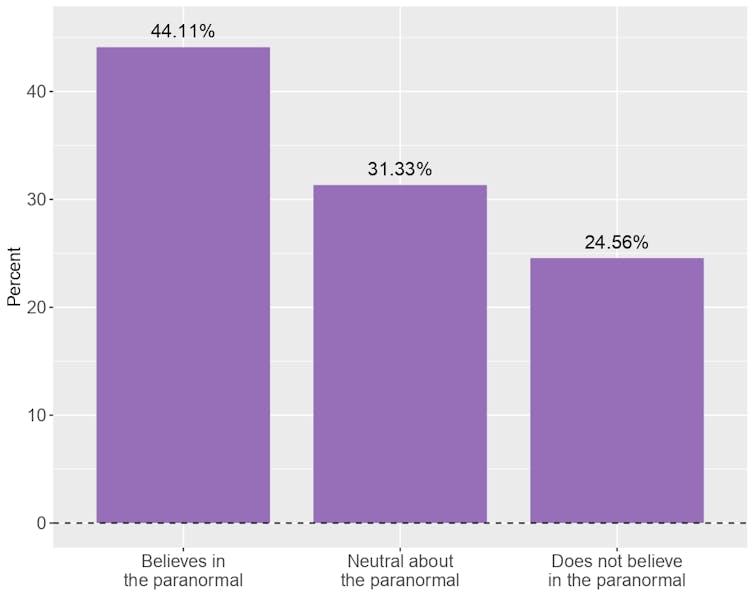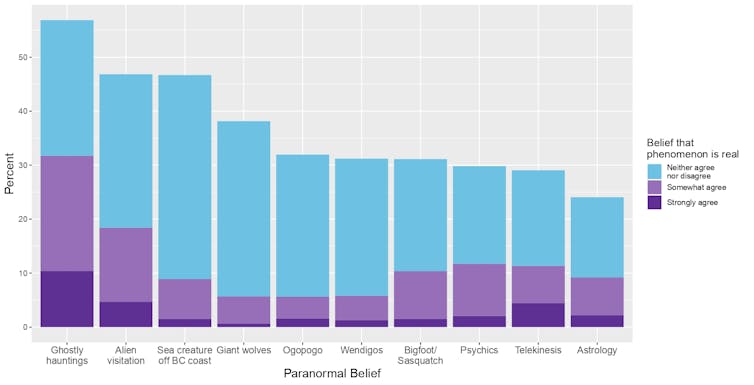What would you say if you were told that paranormal activity exists? Well, nearly half of Canadians would agree.
What is the paranormal, exactly? It refers to phenomena that science cannot explain and are not part of a major religion in a particular society. In contrast, religious phenomena are part of an established doctrine. For example, in Canada, psychic abilities and Bigfoot or Sasquatch are considered paranormal, while angels and demons are associated with religion.
In the summer of 2025, we launched a survey of Canadian attitudes regarding paranormal beliefs in which participation was confidential. And for the first time in decades, we have nationally representative data on paranormal beliefs and encounters in Canada.
Although news outlets regularly publish stories about paranormal beliefs on Halloween, the results they discuss are usually based on convenience samples. Ours is the first study in 20 years to use randomly selected people from the Canadian population to ask these questions — meaning the results are representative.
And it turns out that almost one in two Canadians believe in at least one paranormal phenomenon, and one-quarter report encounters with spirits.
We asked about ghostly hauntings, alien visitations, psychic abilities, telekinesis, astrology and other unexplained phenomena. We also asked about cryptids — animals or creatures whose existence has been suggested but not (yet) proven by science — specific to Canada. They include creatures with roots in First Nations folklore like the large serpentine sea monster, the Cadborosaurus, off the B.C. coast and the Ogopogo in Lake Okanagan.
The believers, the skeptics and the in-between
Canada is one of the world’s most secular societies. Here, religion has little impact on the way people act or view the world.
How Canadians think about the paranormal, however, has been mostly unknown. It’s expensive to gather representative data in Canada and few social scientists think it’s important to study belief in the paranormal. The combination of these two factors has meant Canadian paranormal beliefs have gone unexamined for decades.
What we found is that Canadians have embraced the paranormal — to a point.
Almost half — 44 per cent — believe in at least one paranormal phenomenon. About one-third did not report belief in any paranormal phenomenon but did indicate neutrality about at least one. For example, several respondents did not believe in ghosts, but were on the fence about extraterrestrial visitations.

(Sophia Dimitrakopoulos), CC BY-ND
Only about one-quarter said they did not believe in any of the 10 phenomena we asked about. The percentage of firm non-believers is similar to the 28 per cent figure in the United States and the United Kingdom Belief varied by specific phenomenon. People were most likely to believe in ghostly hauntings.

(Sophia Dimitrakopoulos), CC BY-ND
Overall, it is more common for Canadians to believe in at least one paranormal phenomenon than to not believe in any.
Who is most likely to believe?
Patterns of belief vary somewhat by demographic group.
Women are more likely than men to believe in ghosts and psychics, reflecting how women have a higher probability of being open to phenomena with a spiritual dimension.
People with bachelor’s degrees or higher are less likely to believe in most paranormal phenomena. There are few racial or ethnic differences.
Interestingly, people aged 19-29 are less likely to believe in many paranormal phenomena than those aged 30-44 or 45-64. These findings suggest that young Canadians tend to opt out of any non-scientific belief system, whether religious or paranormal.
Few differences by region or language exist, though francophones are less likely to believe in Sasquatch than anglophones are.
Paranormal experiences in Canada
About one-quarter of Canadians claim to have heard, seen or felt a ghost or spirit. Some experiences were connected to religion, such as feeling the Christian Holy Spirit.
More often, experiences were associated with the death of a loved one and were personally meaningful. As one participant explained: “Soon after my mother’s death, I woke up suddenly and she was standing beside my bed. She smiled at me and faded away. I was comforted.”
Others reported spooky encounters associated with a place. A different participant wrote: “I was managing a motel and saw a ghostly man walking along the upper balcony. I asked the locals, and they said on the property that the motel was on, there was a house that burned down — and he lived in the house!”
Cryptid sightings are less common.
“I was operating a high-clearance sprayer, in a 1,300-acre field. I sat about 10 feet in the air in the cab on this machine,” one participant said. “I came around the corner of a bluff and saw a blurry, bipedal creature. It was furry, had a long snout and long arms, and in an instant turned into a moose. I have no idea to this day what that was.”
What our beliefs reveal
Our goal is not to prove or disprove any experience or belief, but to analyze what they mean for individuals and for Canada.
And to that end, our survey showed us that while many Canadians have replaced or supplemented religious belief with paranormal belief, most trust science. Belief in the paranormal or religion does not mean Canadians reject science, but rather that they believe some phenomena cannot yet be explained by science.
While the paranormal is fun — or creepy — to think about around Halloween, it is also part of the everyday belief system of many Canadians.
![]()
Tony Silva (as co-applicant) received funding from the Social Sciences and Humanities Research Council of Canada for the first survey wave of this project, which focused on attitudes about politics and decarbonisation. No grant or taxpayer funds were used for the second survey wave, which included questions about paranormal beliefs.
Emily Huddart received funding from the Social Sciences and Humanities Research Council of Canada to support an earlier wave of this project (with Tony Silva).


Leave a Reply